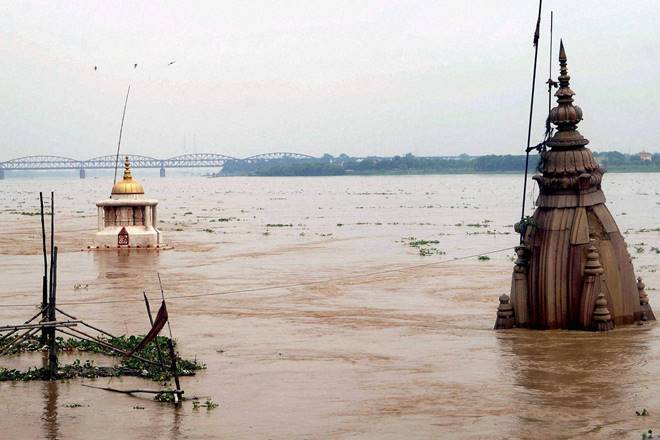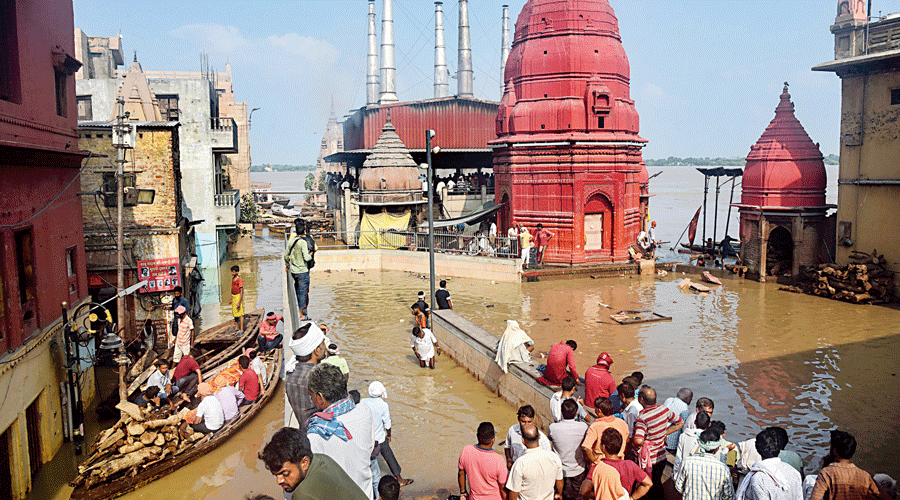Varanasi, India’s revered spiritual capital and one of the world’s oldest living cities, is experiencing one of its worst floods in recent years. With the Ganga river swelling at an alarming rate, the rising waters have submerged all 84 of the city’s ancient ghats and penetrated deep into residential colonies, temples, and rural outskirts. Monsoon rains, which continue intermittently, have wreaked havoc on an already overstretched city infrastructure, displacing thousands and forcing holy rituals to relocate to rooftops and higher platforms.
The visual of Varanasi’s iconic staircase-like ghats disappearing under murky floodwaters has left the city’s residents and devotees heartbroken. Yet, from this adversity, stories of community strength, resourcefulness, and deep-rooted spiritual faith continue to emerge. The situation remains concerning, but efforts are underway at every level to mitigate the disaster and protect lives.

1. All 84 Ghats Submerged: A City’s Heritage Under Water
In a devastating blow to cultural and spiritual life, every one of Varanasi’s 84 ghats lies underwater. Landmarks like Dashashwamedh Ghat, Assi Ghat, and Namo Ghat, which typically vibrate with activity from dawn till late night—aarti ceremonies, prayers, cremations, and boat rides—are now eerily silent and fully submerged.
Even elevated points like the Namaste structures at Namo Ghat are surrounded by water, with the river making its way up municipal roads and temple perimeters. Everyday life around these ghats has come to a standstill, with makeshift barricades now surrounding the access points. Popular places where pilgrims once gathered have now turned into dangerous, fast-flowing waters.
2. Floodwater Enters Residential Colonies and Villages
The river’s fury hasn’t spared low-lying colonies. Water has swallowed entire neighborhoods including Nagwa, Assi, Bhelupur, Konia, and Maruti Nagar, displacing families and destroying personal belongings. In many areas, ground floors are completely flooded, forcing residents to shift to upper floors or evacuee shelters.
In the adjacent rural stretches, smaller villages near the banks have been underwater for days. Narrow roads have been overtaken by flood channels, leaving houses isolated and cut off from essential services. Residents are depending on boats, rope bridges, and help from neighbors to manage evacuation and food distribution.
3. Sacred Rites and Spiritual Activities Affected
The profoundly spiritual rhythm of Varanasi has been severely disrupted. The Ganga Aarti—one of the city’s most iconic and visually stunning evening rituals—has been shifted to temple rooftops or conducted indoors using digital broadcasts for devotees. Priests and devotees alike are emotional yet determined to preserve tradition even in the face of calamity.
Cremations on famous ghats like Manikarnika and Harishchandra are being held on temporary raised platforms or even transported to nearby districts. Many families have had to adapt their final rites and traditions due to access issues, waterlogging, and logistical hurdles.

4. Emergency Services on High Alert
City authorities have mobilized teams of workers, rescue personnel, and volunteers across multiple impacted zones. Inflatable boats, ropes, food packets, and medical kits are being distributed around the clock. The Jal Police and local disaster management units are actively patrolling the ghats and residential streets to monitor water levels and ensure prompt evacuation where needed.
Mobile announcement vans are circulating in the most vulnerable areas to inform, warn, and encourage residents to relocate to safer zones—even when they are initially reluctant to leave their homes. There is ongoing surveillance along the river edge to prevent accidents and sudden surges from surprising unaware residents.
5. Relief Camps and Food Distribution Centers Established
The local administration has set up dozens of relief shelters across the city and outskirts to house affected families. These shelters provide essential amenities like bedding, clean drinking water, toilets, and simple meals. Temporary community kitchens have been activated inside school buildings and community centers to meet the growing demand for food assistance.
Dry ration kits, medical supplies, and hygiene items are also being handed out to help people maintain basic dignity during this chaotic time. Civic volunteers and student groups have played a vital role in distributing aid and calming panic among elderly residents and children.
6. Threat of Disease and Contamination
As water levels continue to stagnate in submerged colonies, public health concerns are rising. Contaminated drinking water, mosquito breeding, and the breakdown of waste management systems have made the threat of disease very real. Health workers have begun spraying disinfectants and deploying anti-larvae measures.
Cases of stomach illnesses, infections, and skin rashes are being reported from flood-hit zones. Additionally, the risk of waterborne diseases such as typhoid, hepatitis, and diarrhea looms large, especially among children and seniors. Medical teams are providing guidance to affected families on safe water practices and sanitation.
With government resources stretched thin, local inventiveness has come to the fore. Makeshift footbridges crafted from bamboo and floating barrels now connect isolated neighborhoods, enabling safer passage for families and the delivery of relief supplies. Residents have adapted wooden carts and rickshaws into amphibious transport, while youth groups coordinate via messaging apps to distribute food packets, sanitary products, and urgent medicines. These grassroots efforts not only support official interventions but strengthen the social fabric in ways that will outlast the flood.
Businesses and Schools Adapt to the Crisis
Varanasi’s small businesses, tea stalls, and markets have transformed their role overnight. Many shop owners are offering shelter to the stranded, distributing free water and snacks, or pooling resources for community kitchens. Educational institutions, forced to suspend in-person classes, have shifted to digital lessons wherever internet connectivity remains, making use of local radio to broadcast learning modules for students in disconnected areas. This swift adaptation ensures a sense of continuity, especially for children whose routines might otherwise be wholly disrupted by disaster.

Ancient Heritage at Risk, but Preservation Efforts Ramp Up
Concerns for Varanasi’s vast heritage sites and millennia-old temples have intensified. Archeological teams, historians, and temple caretakers are monitoring damage to vital structures, applying protective wrappings and shoring up foundations where feasible. There is rising advocacy for integrating flood-resistant design into future preservation projects, blending traditional craftsmanship with modern engineering. These efforts reflect an understanding that safeguarding Varanasi’s tangible heritage is as vital as protecting its people.
Emotional and Spiritual Healing in the Midst of Crisis
Despite the overwhelming difficulties, Varanasi’s renowned spiritual resilience shines through. Daily prayers, group recitations of ancient hymns, and collective meditation are held in temporary shelters or on rooftops, providing emotional solace and uniting individuals from diverse backgrounds. For many residents, the floods have spurred a return to old community values: empathy, selflessness, and shared hope. Even in this period of uncertainty, devotion and togetherness anchor the city, instilling a spirit that will guide recovery once the waters finally recede.
7. Efforts to Protect Animals and Livelihoods
Flooding has not only displaced humans but also left thousands of animals stranded without food or shelter. Many residents have made efforts to carry their pets, cattle, and goats to higher ground. Local animal welfare associations have begun operations to feed stray animals and relocate livestock.
For farmers and vendors, the loss is multiplied. crops stored in houses are ruined, equipment is inaccessible, and daily wage earners are out of work. While the focus remains on immediate safety, citizens are also bracing for long-term economic hardship that will persist even after waters recede.
8. Infrastructure Damage and Transportation Disruptions
The city’s infrastructure has come under severe duress. Several roads have eroded, underpasses are flooded, and rail lines near the city’s bridges are affected. Private vehicle movement in certain zones has been halted, with only essential services allowed to operate.
Debris, mud, and collapsed culverts have made rescue work more difficult in multiple areas. Intercity and local bus services have been limited, while commercial ferry operations, typically a highlight of Varanasi tourism, remain completely suspended.
9. United in Spirit: Community Resilience Shines Through
Despite being battered by nature, the spirit of Varanasi’s people remains unbroken. Neighbors are checking on each other, strangers are offering help without being asked, and shopkeepers are distributing bottled water and biscuits where trucks cannot reach.
Youth volunteers have turned their bikes into mobile delivery systems, relaying medicines and groceries to stranded homes. Entire families are volunteering at shelters. This community cohesion has made it possible to reach remote locations and protect lives continuously over the past week.
Conclusion
As the sacred river continues its rise, swallowing steps, streets, and sanctuaries, Varanasi finds itself wading through uncertainty. But amid the murky water, a different kind of light glows — the humanity and harmony among its people. The city’s ghats may be hidden, its rituals displaced, and its homes breached, but its soul remains undiminished.
In the coming days, as rescue gives way to recovery and mourning shifts to rebuilding, Varanasi’s journey will become a symbol of how enduring faith, collective action, and the indomitable will of people can steer through even the worst floodwaters.
Status Snapshot Table – Varanasi Floods as of July 16, 2025
| Metric | Current Status |
|---|---|
| Ganga Water Level | 68.43 meters (rising) |
| Ghats Fully Submerged | 84 out of 84 |
| Evacuation Shelters Operational | 40+ relief camps across city and rural |
| Religious Activities | Shifted to rooftops and higher ground |
| Cremation Platforms | Raised platforms, makeshift zones |
| Transport | Ferry and boat operations suspended |
| Power, Water Supply | Partial disruption in low-lying areas |
| Animal Relief Drives | Ongoing in rural sectors and colonies |
| Healthcare Risk | High risk of waterborne infections |
Varanasi now watches the skies, listens to the flood sirens, and leans on its heritage of resilience. Even as the ghats await sunlight and dry stone beneath their feet, the spirit of the people assures the world — this city, timeless and sacred, will rise again.
Follow: Flood Forecast
Also Read: Legendary Kannada Cinema Icon B. Saroja Devi Dies at 87: 7 Decades of Unmatched Grace and Glory

